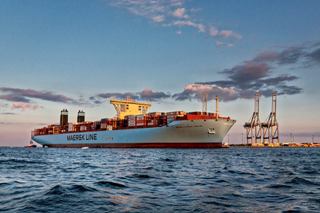 The operational cost benefits from the deployment of the world’s biggest container vessel, the Maersk Mc-Kinney Moller, are starting to become apparent and will prompt more orders for over 16,000-TEU (20-foot-equivalent unit) ships bound for the Asia-Northern Europe trade, predicts Drewry Maritime Research.
The operational cost benefits from the deployment of the world’s biggest container vessel, the Maersk Mc-Kinney Moller, are starting to become apparent and will prompt more orders for over 16,000-TEU (20-foot-equivalent unit) ships bound for the Asia-Northern Europe trade, predicts Drewry Maritime Research.
Maersk Mc-Kinney Moller, the first of Maersk Line’s twenty 18,000-TEU Triple-E ships, entered service between Asia and Northern Europe in August this year.
“The economies of scale offered by Maersk Line’s 18,000-TEU vessels are so great that few can ignore them,” said Drewry.
One of these vessels’ advantages is lower bunker cost, the UK-based research and consulting firm said.
“Assuming the Triple E’s consume 164 tonnes of fuel a day (excluding diesel), the estimated IFO bunker cost of the Maersk Mc-Kinney Moller would already be 35 percent lower than a typical 13,100-TEU vessel on a per TEU carried basis—$218/TEU versus $333/TEU,” it said.
These big ships also have hulls that are reportedly designed around an average ship speed of only 23 knots, compared to over 24 knots for the first 13,000-TEU vessels, enabling them to glide through the water more efficiently.
The mega ships are also assumed to be 85 percent full westbound, and 55 percent full eastbound, which may only be achieved in steady state conditions, when all of the vessels deployed in the AE10 service are Triple Es, said Drewry.
Ship operating costs, including manning, insurance, stores and lubes, repair and maintenance, and administration, are also 11 percent cheaper—$76 per TEU carried versus $85 per TEU carried, Drewry speculated.
“Putting both IFO bunker and ship operating cost savings together reveals that Maerk’s 18,000-TEU ships are a massive 30 percent cheaper than 13,100-TEU ships on a round voyage basis—$294/TEU carried versus $418/TEU carried,” it added.
Specifically, the westbound saving amounted to $121 per TEU, while the eastbound saving was even higher at $128 per TEU.
Other savings include faster cargo handling. According to APM Terminals, berth and crane productivity of the 18,270-TEU Maersk Mc-Kinney Moller last week already reached a record 215 and 37.1 gross moves per hour, respectively, in Rotterdam.
“Normal” berth productivity averages between 140 and 150 moves per hour, and crane productivity averages between 32 and 33 moves per hour for a well-stowed 14,000-TEU vessel.
With its greater size, seven cranes could be worked on the Maersk Mc-Kinney Moller, with the maximum going up to eight, whereas only six can usually be worked on a 14,000-TEU vessel, said Drewry.




